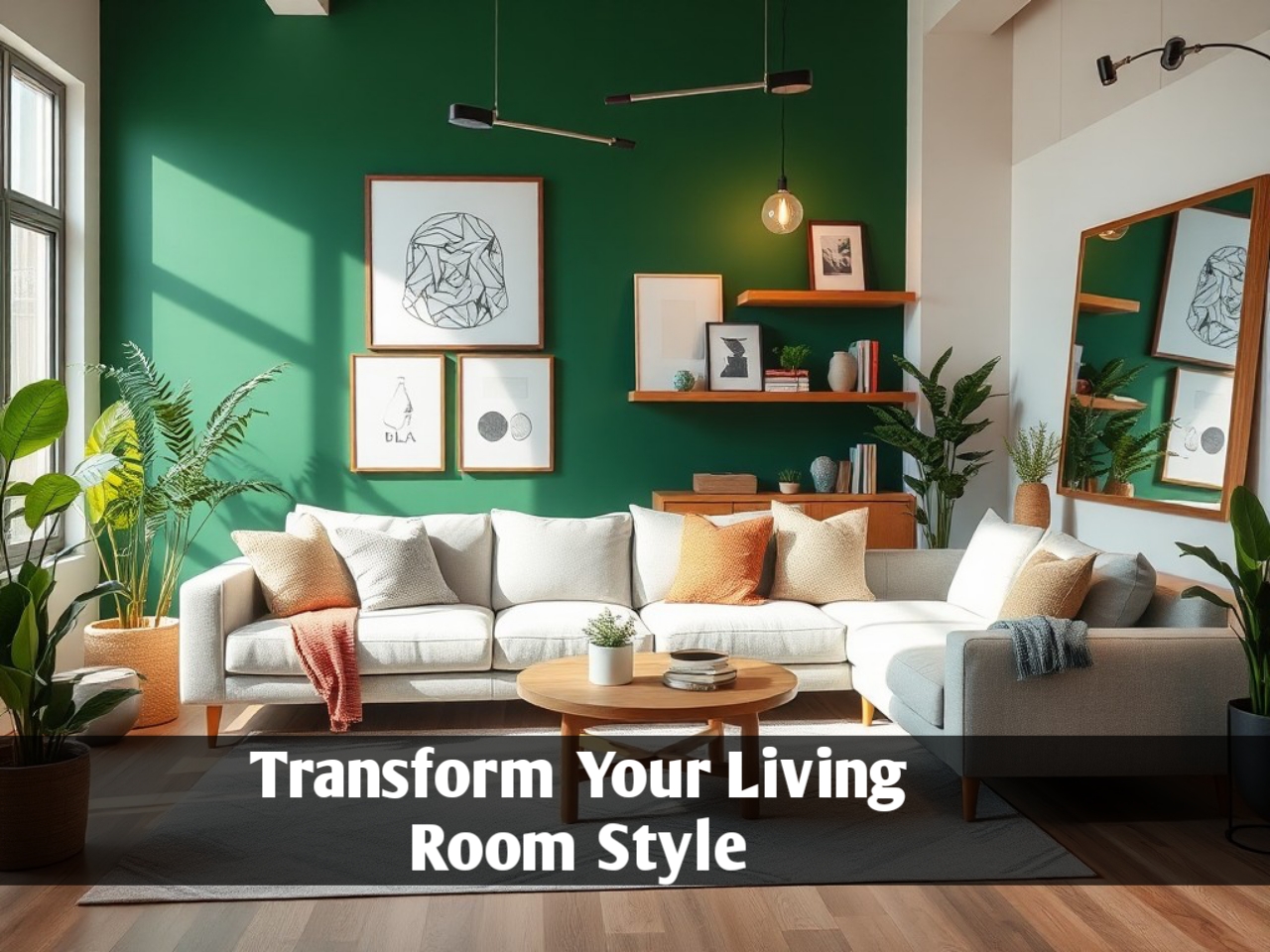30 Inspiring Living Room Ideas to Elevate Your Home Style
Your living room is more than just a space where you relax at the end of the day. It’s the heart of your home, a place where you entertain guests, enjoy family time, and express your personal style. Whether you’re planning a complete renovation or looking for small updates that pack a punch, the right living room ideas can transform your space into something truly special. In this comprehensive guide, we’ll explore 30 inspiring living room ideas that will help elevate your home’s style, making it more functional, beautiful, and welcoming.
1. Embrace a Minimalist Design for a Clean, Modern Look
Minimalism in living room design focuses on simplicity and functionality, creating a space that feels calm and uncluttered. Start by choosing a neutral color palette—think whites, grays, and soft earth tones—and opt for furniture pieces with clean lines. Minimalism doesn’t mean your room has to be devoid of personality; in fact, carefully selected artwork, a statement coffee table, or textured throws can add warmth and interest without overwhelming the space. This design approach is perfect for smaller living rooms where space is at a premium, as it helps create a sense of openness and order.
2. Go Bold with Statement Walls and Vibrant Colors
While neutral tones are timeless, bold colors and statement walls can inject life into your living room. A feature wall painted in a deep, rich color—like navy blue, emerald green, or charcoal gray—can create a stunning focal point. You can also explore wallpaper with bold patterns, from botanical prints to geometric designs, that offer an extra layer of texture and visual interest. Accent the room with complementary cushions, throws, and decor pieces to tie the look together without making the space feel too busy.
3. Incorporate Natural Elements for a Cozy, Earthy Vibe
Bringing natural elements into your living room is a great way to create a warm and inviting atmosphere. Wood is an excellent choice—whether in the form of rustic beams, coffee tables, or shelving units. Pair wooden furniture with natural fabrics like cotton, wool, or linen for your sofas and cushions. Adding plants is another simple yet effective way to enhance the natural vibe. Large potted plants, hanging greenery, or small succulents on your coffee table can breathe life into the space while improving air quality.
4. Mix and Match Textures to Add Depth and Interest
If you’re aiming for a living room that feels layered and luxurious, focusing on texture is key. Mixing materials like leather, wool, velvet, and metal can create depth and make the room feel more dynamic. A leather couch paired with a soft wool throw and velvet cushions adds a tactile element that invites comfort. You can also incorporate textured rugs, such as shag or woven jute, and contrast these with sleek surfaces like a glass coffee table or metallic lighting fixtures.
5. Optimize Your Layout for Functionality and Flow
No matter how beautifully decorated your living room is, if the layout isn’t functional, it will detract from the overall comfort and utility of the space. Start by considering the purpose of your living room—do you use it mainly for entertaining, family gatherings, or as a cozy retreat for yourself? Arrange furniture in a way that encourages conversation, with seating that faces each other rather than being aligned with the walls. In smaller living rooms, multifunctional furniture—like ottomans that double as storage or coffee tables that expand into dining surfaces—can be a game-changer.
6. Add Statement Lighting for a Dramatic Effect
Lighting plays a critical role in shaping the mood and function of your living room. While natural light is always a bonus, the right artificial lighting can completely transform a space. Consider a statement chandelier or pendant light as the centerpiece of your room to draw the eye upwards. Floor lamps and table lamps can add ambient lighting that creates a cozy atmosphere in the evenings. Don’t forget about the practical side—task lighting near reading nooks or accent lighting to highlight artwork can also enhance the functionality of the room.
7. Experiment with Open Shelving for Style and Storage
Open shelving is an excellent way to showcase your personality while keeping things organized. Use shelves to display books, plants, art pieces, and other decor items that reflect your interests. If you prefer a more minimalist look, opt for fewer items and stick to a cohesive color scheme for your decor. Floating shelves, in particular, can make a room feel more open and spacious. If you need additional storage, you can incorporate closed cabinets at the bottom to store items out of sight while keeping the upper part stylish and airy.
8. Use Mirrors to Enhance Space and Light
Mirrors are a designer’s secret weapon for making small spaces feel larger and brighter. A well-placed mirror can reflect light throughout the room, creating an airy and open atmosphere. Consider hanging a large mirror on the wall opposite a window to maximize natural light. If your living room is on the smaller side, a floor-to-ceiling mirror or a gallery of smaller mirrors can also make the room appear more expansive.
9. Incorporate a Gallery Wall for Personal Touches
A gallery wall is a wonderful way to personalize your living room. Choose a mix of art, photographs, and prints that resonate with you—whether they’re family photos, abstract art, or travel memories. Play with different frame styles and sizes to create an eclectic yet cohesive look. For an added layer of sophistication, stick to a color scheme for the artwork itself or the frames. A well-curated gallery wall can act as the focal point of the room, adding visual interest and a personal touch.
10. Introduce Patterned Rugs for Color and Comfort
A beautiful rug can anchor your living room and tie the entire design together. Patterned rugs, in particular, can add a splash of color and personality to an otherwise neutral room. Whether you prefer bold, geometric patterns or softer, vintage-inspired designs, the right rug can enhance the aesthetic and comfort of your space. For a modern look, consider a monochromatic or two-tone rug, while traditional spaces might benefit from Persian or Oriental designs.
11. Create a Cozy Seating Nook for Relaxation
If your living room has an empty corner or awkward space, turn it into a cozy seating nook. All you need is a comfortable chair, a small side table, and a reading lamp to create a tranquil spot perfect for unwinding with a book or cup of tea. Layer the nook with soft throws and cushions for extra comfort. This idea works particularly well in larger living rooms where an additional seating area can add both function and style.
12. Use Large Art Pieces to Make a Statement
Large-scale artwork is a fantastic way to create a dramatic focal point in your living room. Whether you opt for a vibrant abstract painting or a serene landscape, a large art piece can set the tone for the entire room. Pair the artwork with more subtle decor to let it shine, or complement it with smaller pieces in similar tones for a cohesive look. If you’re feeling bold, a gallery wall of large prints can also create an impactful visual display.
13. Incorporate Smart Technology for a Modern Touch
As homes become smarter, so should your living room. From voice-activated lighting and entertainment systems to automated blinds and temperature control, incorporating smart technology can elevate your living room’s functionality. Integrating these technologies into your design can also streamline the aesthetic—concealing wires and devices behind furniture or within walls to maintain a clean, modern look. With technology that adapts to your needs, your living room can become a more efficient and comfortable space.
14. Design a Flexible Space with Multifunctional Furniture
In modern homes, living rooms often serve multiple purposes. Whether your space doubles as a home office, playroom, or entertainment hub, multifunctional furniture can help you make the most of it. Consider a sofa bed for overnight guests, storage ottomans for toys and blankets, or a coffee table with hidden compartments. This kind of furniture is especially useful in smaller homes where maximizing space is key. By carefully selecting versatile pieces, you can maintain style without sacrificing function.
15. Add Vintage Accents for Timeless Elegance
Incorporating vintage elements into your living room can add character and charm that newer items might lack. Whether it’s a mid-century modern chair, an antique mirror, or a retro side table, vintage pieces bring a sense of history and uniqueness to your space. Mix these accents with contemporary furniture for a balanced, eclectic look. Vintage items often come with high-quality craftsmanship and materials, ensuring your living room feels both stylish and durable.
16. Layer Lighting for Ambience and Functionality
Lighting plays a pivotal role in setting the mood in your living room. To create a warm, inviting atmosphere, it’s essential to layer your lighting. Start with a mix of ambient lighting, such as overhead fixtures or recessed lights, to brighten the room. Then add task lighting in specific areas where you’ll need it, like next to a reading chair or above a work desk. Finally, incorporate accent lighting—such as table lamps or LED strips—to highlight art pieces or architectural details. This layered approach ensures your living room is both functional and comfortable, no matter the time of day.
17. Incorporate Personal Decor Pieces for a Customized Look
One of the most effective ways to make your living room feel unique is by incorporating personal decor. This could be anything from souvenirs collected on your travels, handmade crafts, or heirloom furniture pieces passed down through your family. These items add a layer of authenticity to the room, making it feel lived-in and meaningful. While it’s important to maintain balance and not overcrowd the space, personal touches are what make a house feel like a home.
18. Create Visual Interest with an Accent Ceiling
Most people focus on walls and floors when decorating, but the ceiling offers an often-overlooked opportunity to make a design statement. An accent ceiling painted in a contrasting color, covered in wallpaper, or even featuring wooden beams or paneling can add unexpected flair to your living room. This is particularly effective in rooms with high ceilings, where an eye-catching design can draw attention upwards and enhance the feeling of space.
19. Maximize Comfort with Plush Seating Options
No living room is complete without comfortable seating. Whether you prefer a sprawling sectional sofa, a cozy loveseat, or a mix of armchairs and poufs, ensuring that your seating is both comfortable and stylish is key. Look for high-quality cushions and materials that will stand up to daily use. Plush seating doesn’t just have to be soft; it should also offer adequate support for long periods of sitting, whether you’re watching a movie or hosting guests for extended conversations.
20. Play with Scale for a Balanced Look
Creating a balanced living room often comes down to the right proportions. Play with scale by pairing oversized furniture with more delicate items to avoid a heavy or cluttered look. For example, a large sectional sofa can be balanced with a sleek, low-profile coffee table. If you have high ceilings, consider adding taller bookshelves or a statement chandelier to fill the vertical space. This approach ensures that no single piece of furniture dominates the room, creating a harmonious and visually appealing environment.
21. Incorporate Built-In Storage for a Sleek Look
Built-in storage solutions can provide both form and function in your living room. Whether it’s a wall of custom cabinetry, a built-in media console, or floating shelves, these features can maximize space while keeping clutter out of sight. Built-ins offer a sleek, streamlined look, allowing the rest of your decor to take center stage. They’re especially useful in small or awkwardly shaped rooms, where efficient storage is essential.
22. Add a Fireplace for Warmth and Style
Nothing adds coziness and charm to a living room quite like a fireplace. Whether you have a traditional wood-burning fireplace, a modern gas insert, or an electric alternative, this feature can serve as a central focal point in the room. Surround the fireplace with a beautiful mantel and decorate it with plants, art, or candles to enhance its appeal. If you don’t have a fireplace, faux fireplaces can still bring the warmth and look without the installation hassle.
23. Utilize Area Rugs to Define Spaces
In open-concept living rooms, area rugs are an excellent way to define different zones within the same space. A large area rug under the seating area can anchor the living room, while smaller rugs can delineate other sections, such as a reading nook or a workspace. Choose rugs that complement your furniture and color scheme, and don’t be afraid to layer them for added texture and interest.
24. Create Contrast with Dark and Light Elements
Contrast is key to creating a visually dynamic living room. Mix light and dark elements to add depth and intrigue to your space. For instance, dark wood furniture paired with light walls can create a striking contrast that’s both modern and sophisticated. Alternatively, light furnishings against a deep, moody wall color can make the space feel more intimate and luxurious. Playing with contrast in your furniture, textiles, and decor will keep your living room from feeling flat or one-dimensional.
25. Incorporate Geometric Patterns for a Modern Edge
Geometric patterns are a versatile way to introduce a contemporary feel into your living room. Whether through rugs, cushions, wallpaper, or artwork, these patterns add a touch of modernity without overwhelming the space. Choose geometric prints in complementary colors to create a cohesive look. For a more subtle approach, incorporate geometric shapes in lighting fixtures, coffee tables, or shelving units.
26. Add Greenery for a Fresh, Inviting Feel
Plants can do wonders for the atmosphere of a living room, bringing in a sense of nature and freshness. Large, leafy plants like fiddle leaf figs or monstera make bold statements, while smaller succulents or trailing vines can be placed on shelves, side tables, or window sills. Not only do plants purify the air, but they also add an organic element that balances out the more structured aspects of your living room’s design.
27. Opt for a Monochromatic Color Scheme for a Cohesive Look
A monochromatic color scheme can create a serene and cohesive atmosphere in your living room. This design approach uses varying shades of a single color to create depth and interest without overwhelming the space. For instance, a room decked out in different tones of gray—ranging from charcoal to silver—can feel sophisticated and calm. Break up the monotony with textures like velvet, leather, or metallic accents to add dimension.
28. Incorporate Art Deco Elements for Glamour and Elegance
Art Deco design is all about luxury and glamour. Bring a touch of this timeless style into your living room with bold geometric shapes, rich colors like gold and deep blue, and glossy finishes. You can incorporate Art Deco details through your lighting fixtures, mirrors, or decorative accents like vases and picture frames. For a more dramatic effect, consider an Art Deco-inspired wallpaper or a statement piece of furniture, such as a velvet sofa or mirrored coffee table.
29. Create a Harmonious Flow with Open-Plan Living
If your home features an open-plan layout, it’s crucial to ensure your living room flows seamlessly with the rest of the space. This can be achieved through consistent color schemes, complementary furniture styles, and strategically placed rugs to define the living area without closing it off. Furniture arrangement plays a vital role here—opt for pieces that don’t block the sightlines between different areas, and use lighting to guide the flow of the room.
30. Personalize Your Space with DIY Decor Projects
There’s something incredibly rewarding about creating your own decor. Whether it’s a hand-painted piece of artwork, a homemade macramé wall hanging, or repurposed furniture, DIY projects add a personal and unique touch to your living room. Not only do they save money, but they also allow you to customize your space in ways that store-bought items can’t. Get creative with your materials, and you’ll have a living room that’s truly one-of-a-kind.
Conclusion
Revamping your living room doesn’t require a complete overhaul or a large budget. By incorporating some of these 30 inspiring living room ideas, you can elevate the style, comfort, and functionality of your space. From minimalist designs and natural elements to bold patterns and smart technology, there’s something here for every taste and home size. Whether you’re looking for a subtle update or a dramatic transformation, these ideas will help you create a living room that not only looks great but also reflects your personality and lifestyle.
Read Also Our This Post: 50 Stunning Kitchen Design Ideas for Every Style and Space

Kamran Khatri is a versatile writer and editor at ExpressZone.co.uk, bringing fresh perspectives and insightful commentary across a wide range of topics. With a passion for exploring diverse subjects—from technology, business, and finance to lifestyle, travel, and the arts—Kamran aims to inform, inspire, and engage readers through well-researched articles and thought-provoking content.
His work spans multiple categories including health, education, pets, entertainment, real estate, and sustainability, reflecting his commitment to delivering knowledge that connects with everyday life. Whether breaking down the latest trends, sharing practical tips, or highlighting cultural insights, Kamran’s writing combines clarity with creativity.
When he’s not crafting stories for ExpressZone.co.uk, Kamran enjoys keeping up with global developments, exploring innovative ideas, and connecting with readers who share his curiosity about the world.







